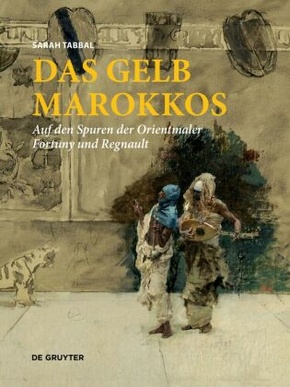Das Gelb Marokkos - Auf den Spuren der Orientmaler Fortuny und Regnault
| Verlag | De Gruyter |
| Auflage | 2023 |
| Seiten | 389 |
| Format | 17,7 x 3,0 x 26,6 cm |
| Gewicht | 1101 g |
| ISBN-10 | 3110737388 |
| ISBN-13 | 9783110737387 |
| Bestell-Nr | 11073738A |
Der katalanische Maler Marià Fortuny i Marsal (1838-1874) und der aus Paris stammende Henri Regnault (1843-1871) sind wichtige Vertreter einer orientalistisch geprägten Kunst. Die transregionale Studie vergleicht zentrale Werke der Maler, analysiert die Rezeption Marokkos in der Kunst Spaniens und Frankreichs und eröffnet somit ein facettenreiches und differenziertes Bild europäischer Orientalismen in der Malerei der zweiten Hälfte des 19. Jahrhunderts. Künstlernetzwerke und wechselseitige Austauschprozesse zwischen französischen und spanischen Marokkomalern stehen im Zentrum der Betrachtung ebenso wie die in der Forschung bisher vernachlässigten Orientalismen Spaniens, das aufgrund seines kulturellen Erbes von al-Andalus im 19. Jahrhundert oftmals zum ,Orient' gezählt wurde.
Rezeption Marokkos durch europäische Künstler in der Vorprotektoratszeit Erstmalige Betrachtung der bisher vernachlässigten Orientalismen Spaniens im 19. Jahrhundert
Catalan painter Marià Fortuny i Marsal (1838-1874) and Henri Regnault (1843-1871), from Paris, were important representatives of an art influenced by the Orient. This transregional study compares key works by the painters, and analyzes the reception of Morocco in the art of Spain and France; the outcome is a multifaceted, differentiated picture of European orientalism in painting during the second half of the 19th century. The analysis focuses on artist networks and reciprocal exchange processes between French and Spanish Moroccan painters, as well as on Spanish orientalism, which has been neglected in research up until now. Due to its cultural heritage from Al-Andalus, Spain was often considered part of the 'Orient' in the 19th century.
Reception of Morocco by European artists in the pre-protectorate period First examination of Spain's previously neglected 19th century orientalism

